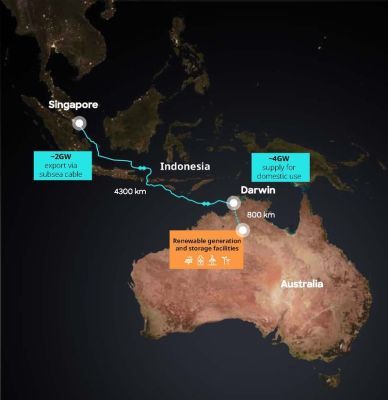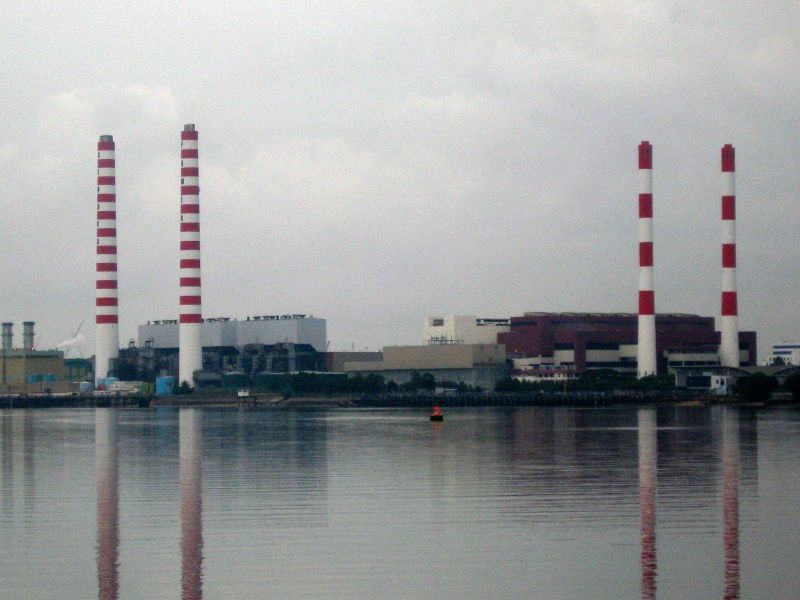
Recently Singapore’s Energy Market Authority (EMA) granted Sun Cable conditional approval for its transmission line with Australia. Singapore has been faced for years now with the dilemma that its population’s energy needs keep increasing year-over-year, while it has very little space to build out its energy-producing infrastructure, least of all renewables with their massive footprints. This has left Singapore virtually completely dependent on natural gas-burning thermal plants.
With no nearby countries to obtain excess power from as is common in e.g. the EU’s integrated energy market, an idea was floated in 2020 by Australian company Sun Cable for the project, called the Australia-Asia Power Link (AAPL). This would entail two transmission lines:
- the 800 km long DarwinLink to a yet-to-be-built multi-GW, 12,400 hectares solar farm in the Barkly Region of the Northern Territory. This link would be rated for 4 GW of transmission capacity.
- the 4300 km long SingaporeLink HVDC line from Darwin to Singapore, rated for 2 GW (1.75 GW after losses).
Back in 2023 Sun Cable went into voluntary administration after the two billionaires providing venture capital for Sun Cable had disagreements about the company’s ‘funding and direction’. It’s unknown in how far these issues are resolved, even as Singapore’s EMA seems to have given conditional approval to the SingaporeLink transmission line. This comes against the background of Singapore having signed a 30-year nuclear power deal with the US and is exploring the eventual deployment of nuclear power as well as the importing of large quantities of ammonia and (green) hydrogen.
The current planning for the whole Sun Cable project is set for completion by 2035, with construction yet to begin on all three components. There are still many uncertainties to be resolved, as the 1.75 GW that would be provided 24/7 to Singapore would have to be backed up by significant grid-level storage on both sides, which is not an easy problem to solve.
If completed, it would be the world’s longest electricity transmission line, providing enough power for ~9% of Singapore’s 2024 energy needs, and likely far below that by 2035. Naturally, all of these projections are eerily reminiscent of the EU’s continuously revived plans to import solar power and hydrogen from Africa.
Featured image: Senoko natural gas and oil-fired power station, Singapore in 2007. (Credit: Terence Ong)
















Maybe they need more HaD readers! https://hackaday.com/2019/10/03/floating-power-plants-the-coastal-city-solution-sure-to-be-increasingly-popular/
Now, for that kind of power they’ll need about 60 of those little ones, or a half dozen Enterprise-class ships.
Jeez, that’s a lot of power. 250 MW in loss alone in that power line.
In scale it’s not so far off the UK scheme: https://renewablesnow.com/news/subsea-link-to-bring-power-to-uk-from-105-gwp-wind-solar-complex-in-morocco-755466/
What’s the macro-scale effect of altering the albedo of a huge chunk of desert? Apparently non-trivial global effects: https://ideas.ted.com/solar-farm-sahara-desert-climate-impact-effects/
Actually, a lot of the volume of an Enterprise-class ship is for things other than propulsion. Why not a ship of similar volume with multiple reactors?
Well, is a proliferation concern, for starters.
The reactors used to propel ships require a much higher degree of fuel refinement than ones used for on-shore power generation. Not like, weapons grade, but much closer to it.
That and the lack of security that comes with being a military vessel…
This ends well, obviously.
It looks like a truly ludicrous plan. Maybe it is a joke? There was once a parody paper in the US called “The Cross-Con Canal” (?). IIRC it was presented as a government plan to bring Mississippi River water to Southern California and it would be made with a long string of nuclear explosions. It was taken quite seriously by anti-nuke and environmental activists and triggered various investigations. This cable scheme must be similar? I mean, China’s CCP would cut it just because it is there. Why not get on the thorium reactor list?
” I mean, China’s CCP would cut it just because it is there.”
Perhaps you should not expect the same behaviour of China; and in fact all other countries on the planet, as that from the goddamn US?
The US hasn’t been caught dragging ship anchors across other countries’ underseas cables lately.
https://www.forbes.com/sites/erictegler/2023/11/28/investigating-the-chinese-ship-that-accidentally-hit-undersea-lines/
Insanely risky from a strategic point of view, it would make Singapore so vulnerable, because if one guy can take out a gas pipeline the same can happen to a HV cable. Actually turning the power into hydrogen, or aluminium, then shipping it to the destination to generate “clean” power would make far more sense.
If the research into aluminum based power generation goes well, it actually does seem like an interesting solution for storing and transporting energy.
Based on the 1.75 GW and some Wikipedia searching, they could theoretically supply the same energy with one small cargo ship delivering aluminum each week. (and one extra ship taking the oxide back)
I get that the point is that the Australian interior has ample sunshine and not much else, but it just doesn’t seem likely to me that this is a more workable solution for Singapore than getting the power from closer to home. Be it tidal/current/wave power, (marine) wind, solar on roofs, nuclear, or a combination thereof. And if they keep importing some, it seems weird to me for them to completely bypass all of Indonesia.
What happened to their plans of building a gigantic floating PV-plant on the nearby indonesian islands?
https://www.reuters.com/business/energy/sunseap-build-2-bln-floating-solar-farm-indonesia-worlds-largest-2021-07-22/
I think you need to have better understanding of Singapore to understand its intention. Singapore is not short of power generation, from gas-driven generators so far. The purpose of the project is not that it short of power generation, it is about how to meet the carbon footprint target by switching to renewable energy, if not 100%. The total land space of Singapore is 751 sq km, the Australia project is 12,400 hectares (125 sq km or approximate 17% of the size of Singapore), obviously Singapore has no land for (solar energy) nor seas (for wind power) for any renewable energy options. For those who are not familiar with Singapore, you might argues why not getting power from nearby neighbours such as Malaysia and Indonesia. Well, Singapore is the most military-defended country (https://www.youtube.com/watch?v=LddXjew1V2Q), and the assumptions were always and still are that if there is any conflict occured, it would be likely with the two countries (if you think of the religion, you would understand why). So historically, all the strategic planning of Singapore are always have this in mind. It is also for this reason that Singapore kept some of its lighter jets and navy vessels in Darwin. It is why Singapore is doing such an expensive project, all for strategic considerations.
Singapore reducing their carbon footprint even 100% is still pissing in the ocean compared to China which produces more carbon emissions than all other industrialized countries combined. Don’t buy their “going green” rhetoric. The CCP lies.
Fixed the title [in brackets]:
China is building six times more new coal plants than [all other] other countries [combined], report finds – March 2, 2023
https://www.npr.org/2023/03/02/1160441919/china-is-building-six-times-more-new-coal-plants-than-other-countries-report-fin
“Everybody else is moving away from coal and China seems to be stepping on the gas,” she says. “We saw that China has six times as much plants starting construction as the rest of the world combined.“
https://cms.zerohedge.com/s3/files/inline-images/US%20China%20fossil%20fuels.png
Solar panel manufacturing by country:
https://elements.visualcapitalist.com/wp-content/uploads/2022/08/Solar-PV-Manufacturing-Aug-29.jpg
Used in wind generators and EV car motors:
Rare Earth Permanent Magnets
Supply Chain Deep Dive Assessment
See page ix:
https://www.energy.gov/sites/default/files/2022-02/Neodymium%20Magnets%20Supply%20Chain%20Report%20-%20Final.pdf
UK power systems engineer: NetZero cannot be taken seriously – 24 Jul 2023
https://rumble.com/v321hj4-why-netzero-cannot-be-taken-seriously.html
And here comes the propaganda as predicted.
And people bank on Tesla, they should bank on propaganda instead, there your dollar is safe for the next 500+ years.
Why doesn’t Australia just close shop and move to EU?
Because they’re keeping the lights on for the true British fleeing the immigrant dystopia?
As previous commenters have noted, this is a telling development from a geopolitical and security perspective. A 4,300 km high voltage DC (HVDC) cable is quite a feat of engineering and expensive. One might wonder why not run a shorter cable to nearby countries (Thailand and Vietnam are just two of several). To my naive mind, this suggests a certain shortage of cooperation and friendship in the immediate region. Electricity to hydrogen by ship is intriguing. I assume hydrogen by pipeline would be rather lower tech than HVDC, yet too novel to be reliable. I imagine the commercial energy wonks have thought this all through.
Singapore is very good at making decisions that pay off in the long term and this looks like it. Huge up front cost, that you amortize over 20yrs, and near zero maintenance cost. Crazy but reasonable from a 50yr thinking position. Like trying to catch a rocket. Living near the coast my solar is constantly reduced by clouds and the marine layer. I have no doubt that Australia’s inland areas will be a more reliable place to put a huge solar farm plus room to grow. Also, I could see Singapore using this to sell excess energy to Malaysia and Indonesia, since they have 2nd and 3rd world economies and will need abundunt energy to fuel their growth and development. Also Singapore can always add backup generation.
Strikes me, one cable fault and that is one hell of a big flash and bang!